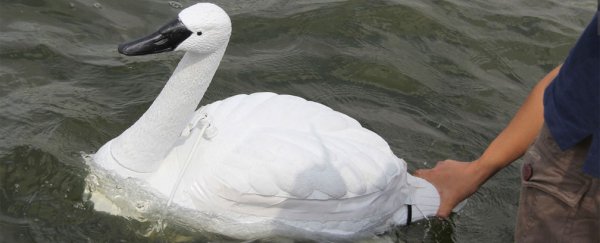If you're going to deploy a fleet of automated robots to monitor water quality in urban areas, why not do it with some style? That's the thinking behind NUSwan, a flock of environmentally friendly swan-bots that researchers from the National University of Singapore have recently deployed in local urban reservoirs.
The NUSwans were designed to blend seamlessly into the environment as they paddle about, their serene visage betraying none of the busy work that goes on below the surface as they tirelessly assess water quality samples more cheaply and efficiently than other automated technologies.
"We started with a number of smaller bird models, before we decided on the swan. It's just the right size," project leader Mandar Chitre told Jack Board at Channel News Asia. "If you look at it in the environment, it just looks like a swan swimming around."
The researchers began looking into the concept of roving robot swans to assess water pollutants back in 2010, but only began deploying test prototypes last year. Compared to conventional water quality monitoring performed by human researchers on boats, the automated and power-efficient robot swans are said to save time and offer numerous cost advantages. And they look cute as well.
"It would be expensive to do similar monitoring manually or using AUVs (Autonomous Underwater Vehicles)," said Chitre. "Hence to reduce reliance on manpower and increase efficiency in water quality monitoring, we are constantly looking into developing new technology with improved capabilities."
The NUSwan units are each fitted with GPS navigation features so each bird in the robo-flock can efficiently monitor its correct patch on the water and keep track of where it's already taken samples. When their power runs low, the swans are programmed to paddle back to base for a recharge.
They're capable of being remotely controlled by human operators, but are designed to act autonomously wherever possible. The units are capable of measuring pH, chlorophyll, dissolved oxygen, and turbidity levels in the water, wirelessly uploading data to the cloud as they go.
While they might look delicate, the robot swans have been designed to be as resilient as possible in order to withstand the kinds of occupational hazards they're likely to encounter. The researchers say they'll survive collisions with kayakers and even small boats without taking any serious damage.
The NUSwan's diverse feature set has reportedly attracted interest from other Asian countries, including China, which may seek to distribute the swans throughout some of its heavily polluted rivers.
"Scientifically, the NUSwan test drives a new paradigm of freshwater monitoring, one that is persistent and interactive, and is potentially able to sample the dynamics of water quality over space and time at improved resolution at an affordable cost," said Chitre.
"We see the potential of having NUSwans deployed in urban freshwater bodies and coastal water beyond Singapore. With the data stored in the cloud, collaborators may share and aggregate data and understand global phenomena."
